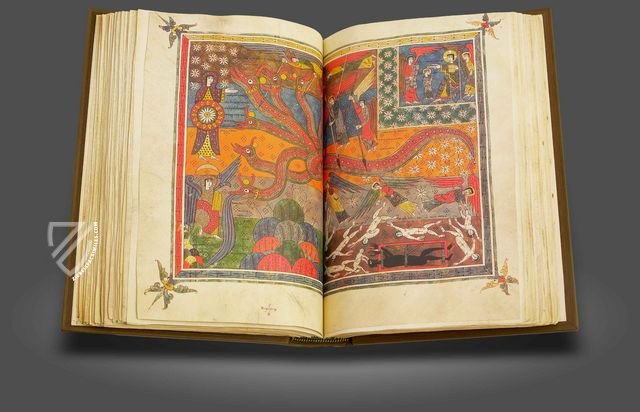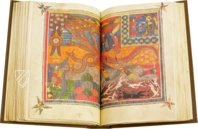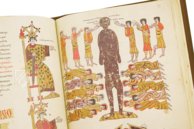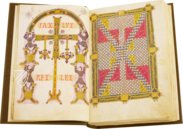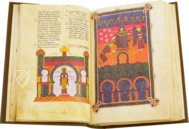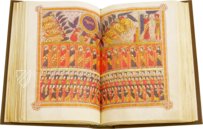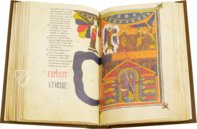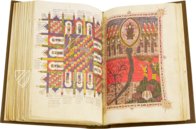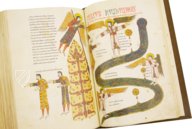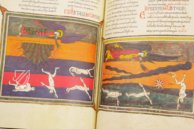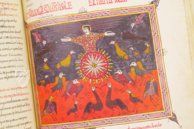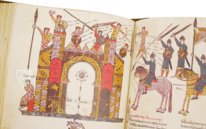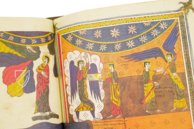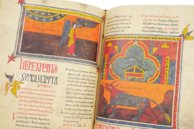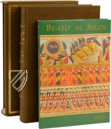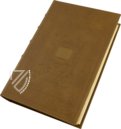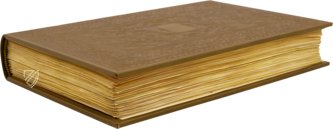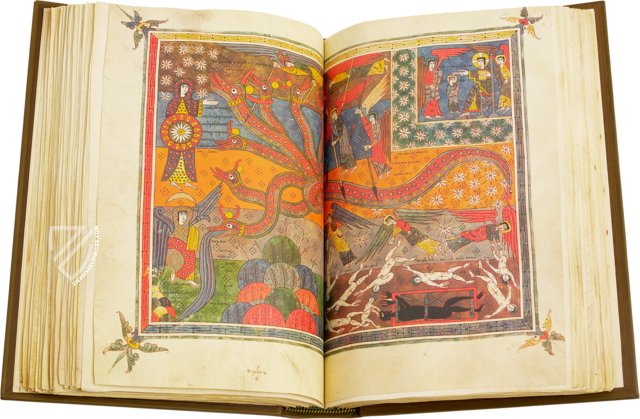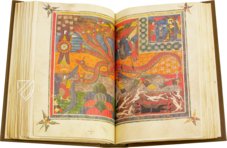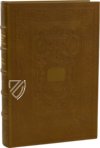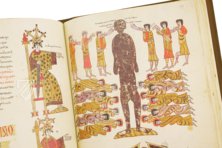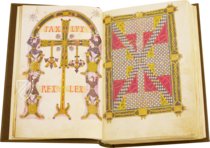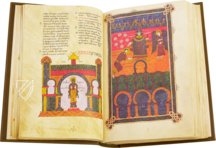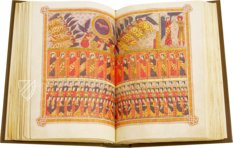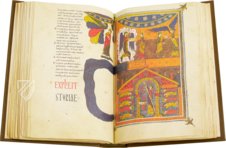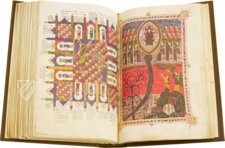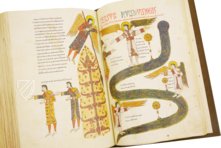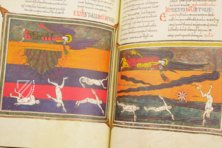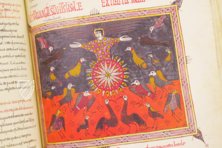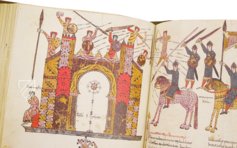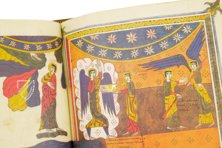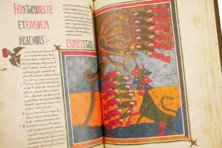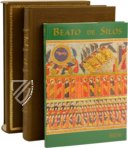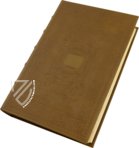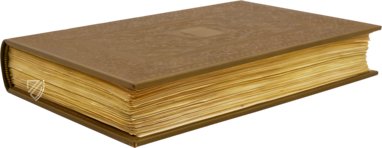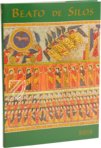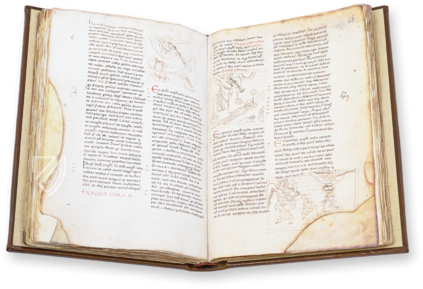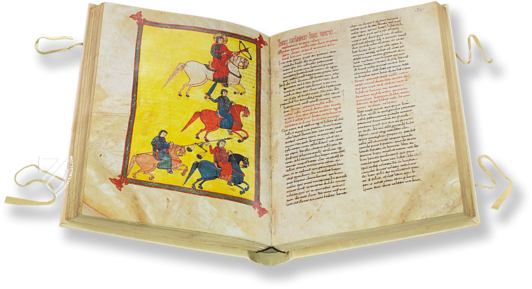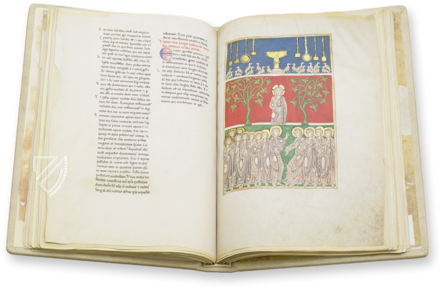Beatus of Liébana - Silos Codex
(7,000€ - 10,000€)
The Silos Codex is one of the newest manuscripts in the Beatus tradition. The document originates from the scriptorium of the Santo Domingo Monastery in Silos between 1091 and 1109. The work contains 106 exciting miniatures embellished with gold. The oldest brother of Napoleon, Joseph Bonaparte, assigned the manuscript to the British Museum in 1840.
Beatus of Liébana - Silos Codex
The Book of Revelation, which is also known as the Apocalypse, is the last book of the New Testament. The story of the end of the world, of Judgement Day, of the sinners’ descent into hell, tremendously fascinated Christians from every land. A Spanish monk by the name of Beatus wrote a commentary on this book from the Bible, which was adapted over several centuries thereafter. The Silos Codex is one of the newest editions of the Beatus manuscripts. The valuable original of the manuscript is found today in the British Museum in London.
Who Was Beatus?
Beatus of Liébana was a monk and theologian, who belonged to the Monastery of Santo Toribio de Liébana in Spain. The monk is famous above all for his magnum opus, a commentary on the biblical Apocalypse in twelve books. These twelve books originate from ca. 776 and are known today as the Beatus-Series. The twelve books were adapted into countless manuscripts, many of which survive to this day. The majority of Beatus manuscripts originate from between the 10th and 12th centuries in northern Spain. The Beatus manuscript of Silos was completed in 1109.
A Well Documented Masterpiece
As is noted several times in the Beatus codex, the text by the scribes Dominicus and Petrus was completed in April 1091, while the miniatures by the illuminator Petrus were finished on July 1, 1109. The work was begun under the direction of Abbot Fortunius von Santo Dominigo de Silos. After his death, it was carried on under Abbots Nunnus and Johannes. Joseph Bonaparte, the older brother of Napoleon, acquired the work when he was King of Spain. In 1840 he sold it to the British Museum, where it is found today.
Stylistic Particularities
At the end of the 11th century, there were profound changes in ecclesiastical and cultural life in the Christian kingdom in northern Spain. Art and architecture increasingly approximated the Romanesque forms prevalent in France. These influences occasionally show themselves in the marginal miniatures of the Silos Codex. The first miniature is an extraordinary depiction of Hell, in which a rich man and a lewd couple are tormented by several demons. Further depictions show angels and multiple Johns in various garb. He sashays through the pictures in more fashionable worldly clothes with a splendid headdress. The true allure of the miniatures of the Silos Codex does not come from their artistic perfection, but rather from their modern narrative style. The unusual illustrations make the Silos edition one of the most interesting versions of the Beatus manuscripts.
Codicology
- Alternative Titles
- Beatus von Liébana - Codex von Silos
Beato de Liébana, códice del Monasterio de Santo Domingo de Silos, Burgos
Silos Beatus - Codex of the Monastery of Santo Domingo de Silos
Beatus von Silos - Codex aus dem Kloster von Santo Domingo von Silos
Beato di Silos - Codice del Monastero di Santo Domingo de Silos
Beato de Silos - Códice do Mosteiro de Santo Domingo de Silos
Béatus de Silos - Codex du Monastère de Santo Domingo de Silos
Silos Beatus
Beatus of Liébana
Silos, Silos Apocalypse - Size / Format
- 560 pages / 38.0 × 25.0 cm
- Origin
- Spain
- Date
- April 18th, 1091 – June 30th, 1109
- Epochs
- Style
- Genre
- Language
- Script
- Visigothic
- Illustrations
- 106 miniatures, illuminated with gold
- Content
- Commentary on the Book of Revelation by Beatus of Liébana
Commentary on the Book of Daniel by Saint Jerome
Antiphonary
Excerpt from the Etymologies by Isadore of Seville
Various texts from St. Jerome, St. Gregory and St. Augustine
Division of Duties for - Patron
- Abbot Fortunio
Abbot Nunnus
Abbot John - Artist / School
- Beatus of Liébana (died after 798) (author)
Monks Domingo and Muño (scribes)
Pedro (illuminator) - Previous Owners
- Cardinal Antonio of Aragon
Pascal of Aragon
King Charles IV of Spain
Joseph Bonaparte, King of Spain
Beatus of Liébana - Silos Codex
The Sealed of Israel
In Rev. 7, four angels stand at the corners of the earth holding back the winds as another angel appears in the east carrying the seal of the living God, which will be applied to the foreheads of the 144,000 chosen ones from the twelve tribes of Israel. The angel, who tells the others not to harm the earth and the sea until the faithful are sealed, is depicted here emerging from the sun upside down with a cross-staff in his hand and flanked by two of the angels restraining the winds in the corners.
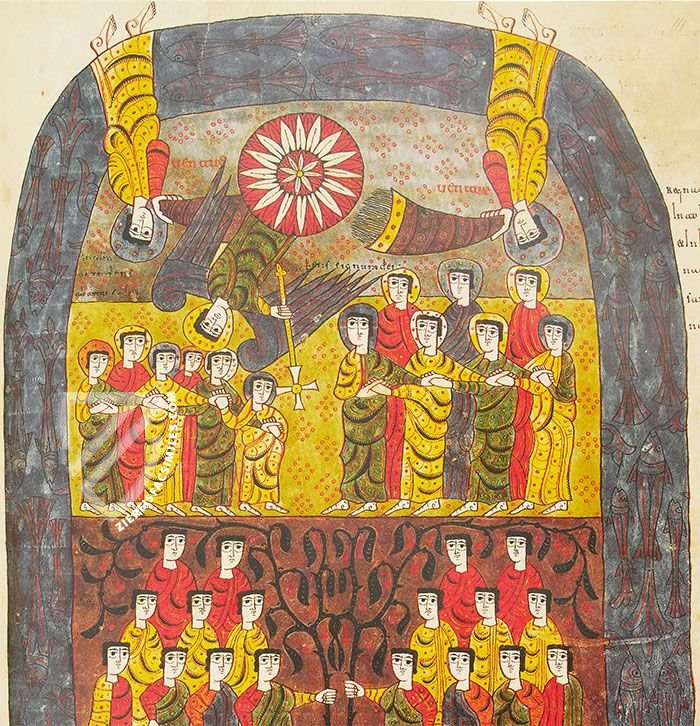
Beatus of Liébana - Silos Codex
Hell
This famous image of Hell is distinguished by its rarity and the complexity of its iconography, which draws from traditions ranging from Gnosticism to Ancient Egypt. Presented in a four-lobed frame corresponding to the golden ratio, it depicts the punishment of a rich man named Dives (center) by the devils Beelzebub (left), Radamas (bottom), Athimos (right), and Barrabas (top).
Outside the frame, the Archangel Michael holds scales to weigh souls in the manner of the Egyptian god Toth. The sin of Avarice is emphasized by placing it in the center, where the figure has two snakes biting his head while his feet are bitten by two toads symbolizing the enemies of the Egyptian god Ra. Lust, the only other sin depicted, is represented by two lovers wrapped in a blanket.
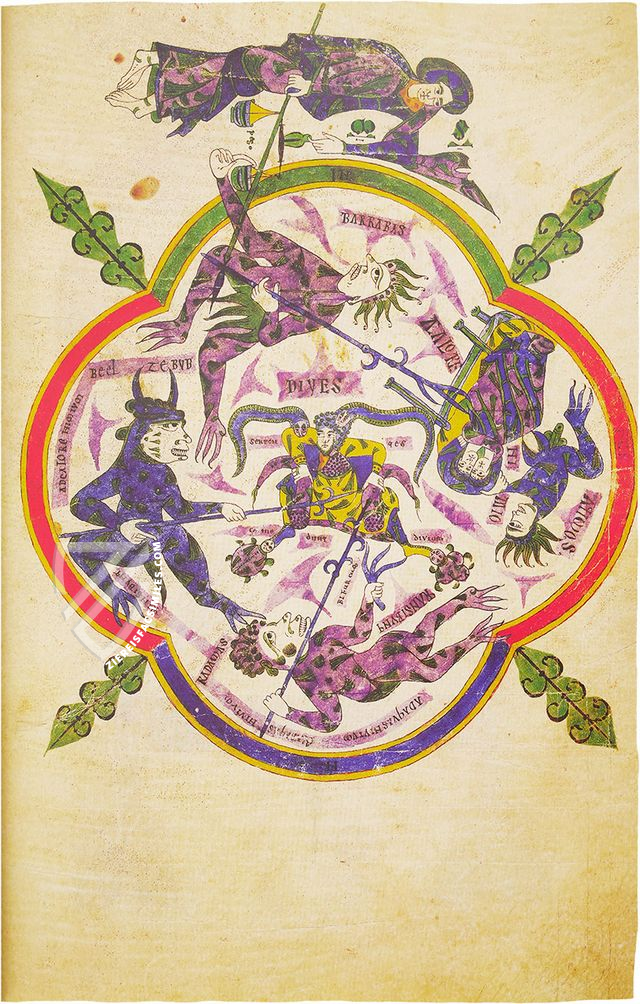
#1 Beato de Liébana, códice del Monasterio de Santo Domingo de Silos, Burgos
Languages: English, Spanish
(7,000€ - 10,000€)
- Treatises / Secular Books
- Apocalypses / Beatus
- Astronomy / Astrology
- Bestiaries
- Bibles / Gospels
- Chronicles / History / Law
- Geography / Maps
- Saints' Lives
- Islam / Oriental
- Judaism / Hebrew
- Single Leaf Collections
- Leonardo da Vinci
- Literature / Poetry
- Liturgical Manuscripts
- Medicine / Botany / Alchemy
- Music
- Mythology / Prophecies
- Psalters
- Other Religious Books
- Games / Hunting
- Private Devotion Books
- Other Genres
- Afghanistan
- Armenia
- Austria
- Belgium
- Belize
- Bosnia and Herzegovina
- China
- Colombia
- Costa Rica
- Croatia
- Cyprus
- Czech Republic
- Denmark
- Egypt
- El Salvador
- Ethiopia
- France
- Germany
- Greece
- Guatemala
- Honduras
- Hungary
- India
- Iran
- Iraq
- Israel
- Italy
- Japan
- Jordan
- Kazakhstan
- Kyrgyzstan
- Lebanon
- Liechtenstein
- Luxembourg
- Mexico
- Morocco
- Netherlands
- Palestine
- Panama
- Peru
- Poland
- Portugal
- Romania
- Russia
- Serbia
- Spain
- Sri Lanka
- Sweden
- Switzerland
- Syria
- Tajikistan
- Turkey
- Turkmenistan
- Ukraine
- United Kingdom
- United States
- Uzbekistan
- Vatican City
- A. Oosthoek, van Holkema & Warendorf
- Aboca Museum
- Ajuntament de Valencia
- Akademie Verlag
- Akademische Druck- u. Verlagsanstalt (ADEVA)
- Aldo Ausilio Editore - Bottega d’Erasmo
- Alecto Historical Editions
- Alkuin Verlag
- Almqvist & Wiksell
- Amilcare Pizzi
- Andreas & Andreas Verlagsbuchhandlung
- Archa 90
- Archiv Verlag
- Archivi Edizioni
- Arnold Verlag
- ARS
- Ars Magna
- ArtCodex
- AyN Ediciones
- Azimuth Editions
- Badenia Verlag
- Bärenreiter-Verlag
- Belser Verlag
- Belser Verlag / WK Wertkontor
- Benziger Verlag
- Bernardinum Wydawnictwo
- BiblioGemma
- Biblioteca Apostolica Vaticana (Vaticanstadt, Vaticanstadt)
- Bibliotheca Palatina Faksimile Verlag
- Bibliotheca Rara
- Boydell & Brewer
- Bramante Edizioni
- Bredius Genootschap
- Brepols Publishers
- British Library
- C. Weckesser
- Caixa Catalunya
- Canesi
- CAPSA, Ars Scriptoria
- Caratzas Brothers, Publishers
- Carus Verlag
- Casamassima Libri
- Centrum Cartographie Verlag GmbH
- Chavane Verlag
- Christian Brandstätter Verlag
- Circulo Cientifico
- Club Bibliófilo Versol
- Club du Livre
- CM Editores
- Collegium Graphicum
- Collezione Apocrifa Da Vinci
- Comissão Nacional para as Comemorações dos Descobrimentos Portugueses
- Coron Verlag
- Corvina
- CTHS
- D. S. Brewer
- Damon
- De Agostini/UTET
- De Nederlandsche Boekhandel
- De Schutter
- Deuschle & Stemmle
- Deutscher Verlag für Kunstwissenschaft
- DIAMM
- Droz
- E. Schreiber Graphische Kunstanstalten
- Ediciones Boreal
- Ediciones Grial
- Ediclube
- Edições Inapa
- Edilan
- Editalia
- Edition Deuschle
- Edition Georg Popp
- Edition Leipzig
- Edition Libri Illustri
- Editiones Reales Sitios S. L.
- Éditions de l'Oiseau Lyre
- Editions Medicina Rara
- Editorial Casariego
- Editorial Mintzoa
- Editrice Antenore
- Editrice Velar
- Edizioni Edison
- Egeria, S.L.
- Eikon Editores
- Electa
- Emery Walker Limited
- Enciclopèdia Catalana
- Eos-Verlag
- Ephesus Publishing
- Ernst Battenberg
- Eugrammia Press
- Extraordinary Editions
- Fackelverlag
- Facsimila Art & Edition
- Facsimile Editions Ltd.
- Facsimilia Art & Edition Ebert KG
- Faksimile Verlag
- Feuermann Verlag
- Folger Shakespeare Library
- Franco Cosimo Panini Editore
- Friedrich Wittig Verlag
- Fundación Hullera Vasco-Leonesa
- G. Braziller
- Gabriele Mazzotta Editore
- Gebr. Mann Verlag
- Gesellschaft für graphische Industrie
- Getty Research Institute
- Giovanni Domenico de Rossi
- Giunti Editore
- Graffiti
- Grafica European Center of Fine Arts
- Guido Pressler
- Guillermo Blazquez
- Gustav Kiepenheuer
- H. N. Abrams
- Harrassowitz
- Harvard University Press
- Helikon
- Hendrickson Publishers
- Henning Oppermann
- Herder Verlag
- Hes & De Graaf Publishers
- Hoepli
- Holbein-Verlag
- Houghton Library
- Hugo Schmidt Verlag
- Idion Verlag
- Il Bulino, edizioni d'arte
- ILte
- Imago
- Insel Verlag
- Insel-Verlag Anton Kippenberger
- Instituto de Estudios Altoaragoneses
- Instituto Nacional de Antropología e Historia
- Introligatornia Budnik Jerzy
- Istituto dell'Enciclopedia Italiana - Treccani
- Istituto Ellenico di Studi Bizantini e Postbizantini
- Istituto Geografico De Agostini
- Istituto Poligrafico e Zecca dello Stato
- Italarte Art Establishments
- Jan Thorbecke Verlag
- Johnson Reprint Corporation
- Josef Stocker
- Josef Stocker-Schmid
- Jugoslavija
- Karl W. Hiersemann
- Kasper Straube
- Kaydeda Ediciones
- Kindler Verlag / Coron Verlag
- Kodansha International Ltd.
- Konrad Kölbl Verlag
- Kurt Wolff Verlag
- La Liberia dello Stato
- La Linea Editrice
- La Meta Editore
- Lambert Schneider
- Landeskreditbank Baden-Württemberg
- Leo S. Olschki
- Les Incunables
- Liber Artis
- Library of Congress
- Libreria Musicale Italiana
- Lichtdruck
- Lito Immagine Editore
- Lumen Artis
- Lund Humphries
- M. Moleiro Editor
- Maison des Sciences de l'homme et de la société de Poitiers
- Manuscriptum
- Martinus Nijhoff
- Maruzen-Yushodo Co. Ltd.
- MASA
- Massada Publishers
- McGraw-Hill
- Metropolitan Museum of Art
- Militos
- Millennium Liber
- Müller & Schindler
- Nahar - Stavit
- Nahar and Steimatzky
- National Library of Wales
- Neri Pozza
- Nova Charta
- Oceanum Verlag
- Odeon
- Orbis Mediaevalis
- Orbis Pictus
- Österreichische Staatsdruckerei
- Oxford University Press
- Pageant Books
- Parzellers Buchverlag
- Patrimonio Ediciones
- Pattloch Verlag
- PIAF
- Pieper Verlag
- Plon-Nourrit et cie
- Poligrafiche Bolis
- Presses Universitaires de Strasbourg
- Prestel Verlag
- Princeton University Press
- Prisma Verlag
- Priuli & Verlucca, editori
- Pro Sport Verlag
- Propyläen Verlag
- Pytheas Books
- Quaternio Verlag Luzern
- Reales Sitios
- Recht-Verlag
- Reichert Verlag
- Reichsdruckerei
- Reprint Verlag
- Riehn & Reusch
- Roberto Vattori Editore
- Rosenkilde and Bagger
- Roxburghe Club
- Salerno Editrice
- Saltellus Press
- Sandoz
- Sarajevo Svjetlost
- Schöck ArtPrint Kft.
- Schulsinger Brothers
- Scolar Press
- Scrinium
- Scripta Maneant
- Scriptorium
- Shazar
- Siloé, arte y bibliofilia
- SISMEL - Edizioni del Galluzzo
- Sociedad Mexicana de Antropología
- Société des Bibliophiles & Iconophiles de Belgique
- Soncin Publishing
- Sorli Ediciones
- Stainer and Bell
- Studer
- Styria Verlag
- Sumptibus Pragopress
- Szegedi Tudomànyegyetem
- Taberna Libraria
- Tarshish Books
- Taschen
- Tempus Libri
- Testimonio Compañía Editorial
- Thames and Hudson
- The Clear Vue Publishing Partnership Limited
- The Facsimile Codex
- The Folio Society
- The Marquess of Normanby
- The Richard III and Yorkist History Trust
- Tip.Le.Co
- TouchArt
- TREC Publishing House
- TRI Publishing Co.
- Trident Editore
- Tuliba Collection
- Typis Regiae Officinae Polygraphicae
- Union Verlag Berlin
- Universidad de Granada
- University of California Press
- University of Chicago Press
- Urs Graf
- Vallecchi
- Van Wijnen
- VCH, Acta Humaniora
- VDI Verlag
- VEB Deutscher Verlag für Musik
- Verlag Anton Pustet / Andreas Verlag
- Verlag Bibliophile Drucke Josef Stocker
- Verlag der Münchner Drucke
- Verlag für Regionalgeschichte
- Verlag Styria
- Vicent Garcia Editores
- W. Turnowski Ltd.
- W. Turnowsky
- Waanders Printers
- Wiener Mechitharisten-Congregation (Wien, Österreich)
- Wissenschaftliche Buchgesellschaft
- Wissenschaftliche Verlagsgesellschaft
- Wydawnictwo Dolnoslaskie
- Xuntanza Editorial
- Zakład Narodowy
- Zollikofer AG

